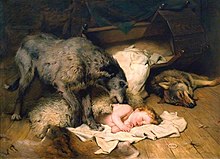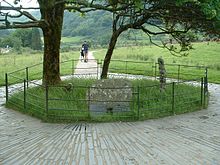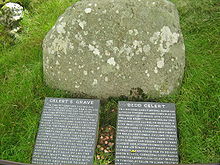Gelert
Gelert ( pronunciation in Welsh [ɡɛlɜɹt] English : [ɡiːlət]) is the name of the dog , which the forecast after the village of Beddgelert ( "Gelerts grave") in Gwynedd , Wales is said to have given its name. The underlying mythical motif of a hastily unjustly killed animal, although it behaved loyally to its humans, is widespread in Europe, the Orient, and South and East Asia. The oldest version comes from India.
legend
The dog Gelert belonged to Prince Llywelyn ab Iorwerth von Gwynedd, who had received it as a gift from King John Unland of England. One day, returning from the hunt, Llywelyn found his young son's cradle knocked over. The baby was nowhere to be found, and Gelert, whom Llywelyn had left to guard the child, was covered in blood. Llywelyn believed that Gelert killed his son and killed the dog with his sword. Shortly afterwards, however, the prince heard a child crying and found his son unharmed under the cradle . Next to it was a wolf that Gelert had killed. Llywelyn regretted his act, had the dog buried in honor and is said to have never laughed again afterwards.
Gelert's grave
In Beddgelert there is a grave that is traditionally referred to as Gelert's grave. This grave was probably not created until the late 18th century by the resident landowner David Prichard, who wanted to promote tourism and improve property prices. The village of Beddgelert may have got its name from an early Christian saint named Kilart or Celert.
There are two slabs of slate on the tomb with the legend of Gelert engraved in Welsh and English . The inscription on the English plate reads:
IN THE 13TH CENTURY, LLYWELYN, PRINCE OF NORTH WALES, HAD A PALACE AT BEDDGELERT. ONE DAY HE WENT HUNTING WITHOUT GELERT “THE FAITHFUL HOUND” WHO WAS UNACCOUNTABLY ABSENT. ON LLYWELYN'S RETURN, THE TRUANT STAINED AND SMEARED WITH BLOOD, JOYFULLY SPRANG TO MEET HIS MASTER. THE PRINCE ALARMED HASTENED TO FIND HIS SON, AND SAW THE INFANT'S COT EMPTY, THE BEDCLOTHES AND FLOOR COVERED WITH BLOOD. THE FRANTIC FATHER PLUNGED THE SWORD INTO THE HOUND'S SIDE THINKING IT HAD KILLED HIS HEIR. THE DOG'S DYING YELL WAS ANSWERED BY A CHILD'S CRY. LLYWELYN SEARCHED AND DISCOVERED HIS BOY UNHARMED BUT NEAR BY LAY THE BODY OF A MIGHTY WOLF WHICH GELERT HAD SLAIN. THE PRINCE FILLED WITH REMORSE IS SAID NEVER TO HAVE SMILED AGAIN. HE BURIED GELERT HERE. THE SPOT IS CALLED BEDDGELERT
reception
The legend was the basis for an epic poem by William Robert Spencer , which he wrote around 1800. The legend is mentioned in various sources, including Wild Wales by George Borrow , Brewster's Dictionary of Phrase and Fable and The Nuttall Encyclopaedia . In English literature, the variants "Gellert" and "Killhart" are also passed down for the name of the dog.
distribution
Similar legend motifs appear in many parts of Europe and Asia. Ten versions are known from China alone. In Liguria there is the poem R sacrifisi dr can , written in Ligurian , in which a shepherd shoots his bloodied shepherd dog, but then finds a dead wolf in the stable. In the region of the Dombes in France, the dog Guinefort was venerated as a saint until the 20th century , whose story is also very similar to that of Gelert. In contrast to Guinefort, however, the Gelert dog was never an object of religious worship.
origin
The oldest version can be found in the ancient Indian Sanskrit poem Panchatantra , which was written before the middle of the 1st millennium. The story contained therein "The Brahmin and the Mungo" is about the household of a Brahmin whose wife gave birth to a son and a mongoose and raises them together. When the woman goes to fetch water, the Brahmin also disappears and leaves the baby unguarded. A black snake crawls out of its hole towards the baby. The mongoose wants to protect the baby, throws itself on the snake and chews it into many pieces. To report proudly of his heroic deed, he approaches the returning mother with a blood-smeared mouth. Convinced that the mongoose had killed her child, the mother kills the mongoose with her water jug.
The spread of history westwards to Europe is thanks to the Arabic text collection Kalīla wa Dimna from the 8th century, which goes back to a lost Middle Persian version from the 6th century. Now a dog replaces the mongoose in the story. A Syrian version (“The Book of Sindibad”) was developed from the Arabic version in the 10th century . In the 13th century, Johann von Capua translated the Arabic text into Latin. The resulting collection of fables, Directorium humanae vitae , was later translated into other European languages. In the Tamil version in South India, the innocently killed animal remained a mongoose, which enjoys a special status as the firstborn son of the family.
See also
Web links
- Bêth-Gelert (PDF; 254 kB), poem by William Robert Spencer
Individual evidence
- ↑ Article on Gelert's grave
- ↑ Borrow's Wild Wales , Chapter XLVI: The Valley of Gelert .
- ↑ Cultura alpina in Liguria , Realdo e Verdeggia, SAGEP EDITRICE, 1984, ISBN 88-7058-106-3
- ^ Jean-Claude Schmitt : Le saint Lévrier - Guinefort, guérisseur d'enfants depuis le XIIIe siècle. 2nd expanded edition. Flammarion, Paris 2004, ISBN 978-2-08-080095-4
- ^ Stuart Blackburn: The Brahmin and the Mongoose: The Narrative Context of a Well-Traveled Tale. In: Bulletin of the School of Oriental and African Studies , University of London, Vol. 59, No. 3, 1996, pp. 494-507


